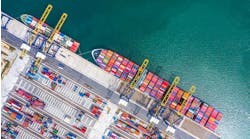As global sourcing continues to grow, choosing the best country is becoming more challenging as governments around the world try to grab their piece of the economic pie.
Although it has sourced subassemblies from Malaysia for five years, it wasn't until this year that Angola, Ind.-headquartered TydenBrammall, Inc. (www.tydenbrammall.com) opened its own facilities in China and the United Kingdom. The company manufactures a variety of cargo seals for truck, rail, container, food and chemical applications. In the North American market, Tyden-Brammall sells directly to end users.
"It helps us stay in touch with their changing product needs," explains Tom Hayes, the company's v.p. global sales and marketing, "Especially with ISO 17712 security necessities, which include as a best practice once-a-year testing by an outside lab and C-TPAT program requirements." Unique in the industry, the manufacturer has established its own in-house lab to meet these security standard requirements.
For the moment TydenBrammall's Chinese operations support U.S. and European operations. Beyond cost savings, TydenBrammall is moving manufacturing offshore to meet competitive needs. Next year the company expects to begin selling to the Asian market from its location in Suzhou, about 60 miles west of Shanghai.
"A lot of our large accounts really prefer us to offer our services in Europe or Asia," notes Hayes. "So we're trying to meet our customer requirements and expand. What they really like to have in Europe is local product stocking, invoicing in local currencies, but also local sales and service support."
In May the company opened a distribution center in Devon, U.K., to serve Europe. It's now building a sales force in the region, and maintaining its network of independent distributors. The European facility will receive product from the United States and China that will be customized for local markets.
What's next? "We just see Central and South American markets as growing to a point where we may need a stronger presence," says Hayes. The company had been doing business through independent distributors in Mexico for 10 years. "We are working with InfoAmericas on some market sizing projects, to help gauge our business plan and understand where we are going."
InfoAmericas (Coral Gables, Fla., www.infoamericas.com) provides business and market intelligence to companies entering Latin American markets. In surveying country and even city assets for companies looking to source outside the United States, Marcio Stewart, director of transportation and logistics for InfoAmericas, says that Latin America is not a place to discuss in general terms. "We split the continent into three tiers," he says. "Tier one is Brazil and Mexico. Tier two are the larger economies after that: Argentina, Chile, Venezuela and Colombia. And Tier three are all the other countries, such as Peru, Bolivia and Uruguay. You cannot discount the Central American bloc. Since CAFTA (Central American Free Trade Agreement) it has attracted a lot of interest and is now a major economic bloc rather than being a series of smaller countries."
He says that the logistics infrastructure always comes up when corporate managers start thinking about moving manufacturing offshore. Until now investment in transportation has not been a high government priority in many of these countries. That is changing because most Latin American countries bring in hard currency through exports. To get exports out of a country requires an efficient shipping system. Stewart talks of logistics systems rather than just infrastructure. "A port is irrelevant unless it is connected to a decent roadway," he points out.
Stewart is optimistic that improvements will come because the demand for upgrading logistics is enormous, along with acceptance and awareness by governments of the need to upgrade.
"The big differentiating factor now is that they have money from the infusion of cash the Chinese are bringing because of Latin America's strategic position to them," he claims. "The Chinese will not stop investing in Latin America as long as it is feeding the factories and their people with agricultural and raw materials."
Stewart says that since China has become the workshop of the world, it has moved to secure raw materials and commodities in order to keep its factories going. "Not only are they investing in raw materials, they're investing in the logistics systems as well, because it's no use investing in a copper mine in Chile if you can't get your copper out," he says.
The Chinese government has recently taken some measures to slow down its economy. It had been growing at an annual rate of 12% and communist party officials decided that was too hot, in the view of Christopher W. Runckle, principal and founder of Runckle & Associates (www.business-in-asia.com). His firm helps U.S. and European companies interested in opening a factory somewhere in Asia. The firm operates in China and has offices in Vietnam, Thailand, Laos and Cambodia.
In China Runckle sees increasing costs for labor and land. While the country has done a lot to build up it's infrastructure, global companies are looking more seriously at other regions.
"The two main markets people are looking at are Vietnam and India," he says. "We're seeing more companies that went into China maybe four or five years ago are now looking at their supply chain and finding out that too much product is coming from one location in China or even, in a lot of cases, one factory in China. So many of them want another location."
Runckle says India has some major problems that still must be overcome. "The biggest problem is infrastructure and the second is bureaucracy. It's a very bureaucratic country," he observes. On the other hand, while Vietnam has significant infrastructure problems, they are being addressed at a much more rapid rate than in India. Vietnam is now in the final stages of being approved for World Trade Organization (WTO) membership. Because of that it has been changing all of its laws to make them more internationally compatible.
"Where China had done that several years ago to go into the WTO, its biggest problem is not the actual laws, it's enforcement of them. The central government often passes what on their face are very good laws but they just don't get enforced. That's not true at all in Vietnam," Runckel says. "With only 83 million people, the country can't ignore the rest of the world. What happens is that much more rapidly you have a more level playing field than really has been the case in China."
The biggest problem in Vietnam, according to Runckle, is that roads and ports are not yet up to the same standard as they are in Thailand, Malaysia and most coastal regions in China. Although the government has put a lot of money into improvement it is now turning to private money for assistance. The government has allowed build-operate-transfer (BOT) projects in its expressway road system, for its ports, electricity and other utilities.
A number of companies have been successful sourcing from Vietnam over the past several years. Among the U.S. companies outsourcing to Vietnam is L. & J.G. Stickley (www.stickley.com), a furniture manufacturer headquartered in Manlius, N.Y., that opened a 187,000 sq.-ft. factory in Binh Duong Province.
A niche industry that's less well known is computer software, notes Runckle. "Vietnam has been quite competitive here with India. They don't have the English language skills but are rapidly moving to get them. The ability to attract good programmers and IT professionals is quite good in Vietnam."
Most development at this time is on the coastal region. Ho Chi Minh City has been the magnet and the engine for growth for all of Vietnam. But now Da Nang, Quang Nam and Quang Ni are growing with many new projects.
"There is a very large steel project, over a billion dollars, that has just been approved by Taiwan," says Runckle. "There is a Korean shipbuilding venture that has over 600 employees at present and will have several thousand in a couple of years. The Da Nang area now has become a sort of secondary engine. In the north the Hanoi area has quite a lot of development that tends to be by the Japanese, the Koreans and Taiwanese."
The Logistics Difference in BrazilLogistics costs as a percentage of gross domestic product in the United States are about 8%. In Brazil they are 12.6%. That difference of four points represents $35 billion in Brazilian terms. That’s the cost that Brazil is paying for its relative inefficiency. In their balance of trade Brazil has a surplus of about $35 billion. So because of logistics inefficiencies they are losing almost as much as they are making through exports. The amount of money required to improve logistics across Latin America is so large—the World Bank says it’s about $400 billion—that governments cannot do it on their own. There must be public-private partnerships between international aid agencies, like the Inter-American Development Bank (IADB), and private enterprises.—Marcio Stewart, InfoAmericas |
Selling to the VietnameseChristopher W. Runckle points out that AT Kearney rates Vietnam as the number three market in the developing world for retail, with China and India number one and two. The perception has not been missed by retailers from around the world. Big players in Vietnam include six supermarkets of Metro Cash and Carry (Germany), Big C (Thailand) has three stores and has just opened a fourth, Levi Strauss has an outlet there, Parkson (Malaysian) has several department stores, Dairy Farm (Singapore) has announced it is opening. Bourbon (France), Lotte (Korea), Costco and WalMart (U.S.) will soon be opening facilities. |
Vietnam’s Biggest Currency EarnersMore than two-thirds of Vietnam’s export revenues came from seven areas. Estimates of export revenues for all of 2005 were $32.32 billion, up 21.6% over 2004. All figures here are U.S. dollars.
| |||||||||||||||||||||||||||


